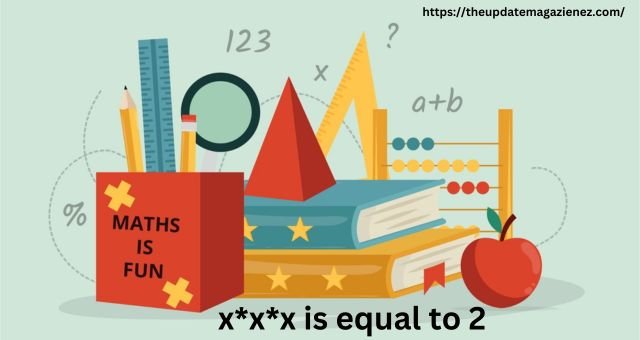Introduction
In the world of mathematics, there are many equations that prove to be very hard to crack and solve. Basically, it can be said that a lot of skills and practice is required to be efficient in mathematics. But until you get there you definitely have to get help from different sources. Well, one of the most interesting and complex equation is “x*x*x is equal to 2”. Many students have been interested in knowing how this equation is solved. Indeed, this blog is going to provide you with all essential information regarding it.
Understanding the equation – “x*x*x is equal to 2”
Basically, it can be described as one of the many interesting equations existing in mathematics. And, it has been in existence for quite a while. Hence, many generations have had the chance to fiddle with this equation.
“x*x*x is equal to 2” looks complicated at first glance. However, it is not as complex in reality. You will also agree once you understand everything about it.
What is the challenge? – “x*x*x is equal to 2”
Evidently, you can bypass the complexity of this equation once you understand it in depth. However, it does a put forward a very interesting challenge. Basically, the challenge her is that to find a number i.e., X. In simple words, this equation challenges every individual to find the value or a number that gets denoted as X. This challenge has indeed proven to be very interesting and appealing to many people.
Breakdown of the equation – “x*x*x is equal to 2”
Before jumping to the solution, it is very crucial to efficiently understand the equation and challenge at hand. For doing so it is important that one breakdown the equation to get ideas where it is going. Evidently, “x*x*x is equal to 2” can also be written as “x3 = 2”. And, the value of x is to be found.
How to approach the solution? – “x*x*x is equal to 2”
The challenge is certainly to find the number or value of X. And, you have to do so in a specific way. Basically, that when multiplying the number by itself three times the result should be 2 as shown in the equation. Multiplying a number by itself is also known as cubing it.
Once the value of X has been founded in such a way that the equation is satisfied. That would be the perfect solution. As you may or may not know, this equation certainly has no kind of simple whole number solution. Therefore, to find the value of X you need to use a specific method. This method is evidently the cube root extraction.
Understanding “Cube Root” in easy language
- Basically, a cube root can be described as a number. And, not just any number. Specifically, when a number i.e., a cube root gets multiplied by itself a total of three time. Consequently, the result is the original number itself.
- In simple words, if a word gets multiplied by itself three times and the result is the same as original number. Then it is a cube root. In addition, multiplying a number by itself three times is also called cubing in mathematics.
- For example, lets suppose our number is “8”. Evidently, the cube root of 8 is 2 for sure. That is certainly because when 2 is multiplied by itself three times (2×2×2). The result would be 8.
What is the method of “cube root extraction”?
- Evidently, the process of finding a number which when gets cubed (multiplied by itself) results in the original number. That refers to “cube root extraction”. Cube root extraction is often done with the help of estimation in the world of mathematics.
- Aside from estimation, the methods of prime factorization and Newton-Raphson are used in case the numbers are complex. Lastly, the method of “cube root extraction” is very crucial in geometry, algebra along with many real-life uses.
The solution of “x*x*x is equal to 2” with steps (Using cube root extraction)
- Firstly, you need to start with the equation. It will be written as:
- x3 = 2
- Thereafter, you need to take the cube root of both the sides of the “=”. And, you need to isolate X.
- When calculated, the cube root of 2 would be 1.26.
- To be more specific, the answer would be “X = 1.2599”.
- Indeed, the answer is not exactly 2 but close to it. That is the twist in this equation.

Conclusion
Indeed, this is a simple equation with a complex answer. For the same reason, it appears to be complicated. And, when looking at it for the first time, there is a lot of speculation. Without a doubt, anyone would wonder how to approach the solution for this.
[AUTHOR – PIYUSH CHAUHAN]


